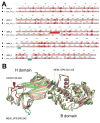Candidate new rotavirus species in sheltered dogs, Hungary
- PMID: 25811414
- PMCID: PMC4378476
- DOI: 10.3201/eid2104.141370
Candidate new rotavirus species in sheltered dogs, Hungary
Abstract
We identified unusual rotavirus strains in fecal specimens from sheltered dogs in Hungary by viral metagenomics. The novel rotavirus species displayed limited genome sequence homology to representatives of the 8 rotavirus species, A-H, and qualifies as a candidate new rotavirus species that we tentatively named Rotavirus I.
Keywords: Hungary; astrovirus; coronavirus; dogs; parvovirus; picodicistrovirus; rotavirus; semiconductor sequencing; vesivirus; viral metagenomics; viruses.
Figures


References
-
- Estes MK, Kapikian AZ. Rotaviruses. In: Knipe DM, Howley PM, Griffin DE, Lamb RA, Martin MA, Roizman B, et al., editors. Fields virology. 5th ed. Philadelphia: Lippincott Williams & Wilkins; 2007. p. 1917–74.
Publication types
MeSH terms
Substances
Associated data
- Actions
- Actions
- Actions
- Actions
- Actions
- Actions
- Actions
- Actions
- Actions
- Actions
- Actions
- Actions
- Actions
- Actions
- Actions
- Actions
- Actions
- Actions
- Actions
- Actions
- Actions
- Actions
LinkOut - more resources
Full Text Sources
Other Literature Sources
Medical

